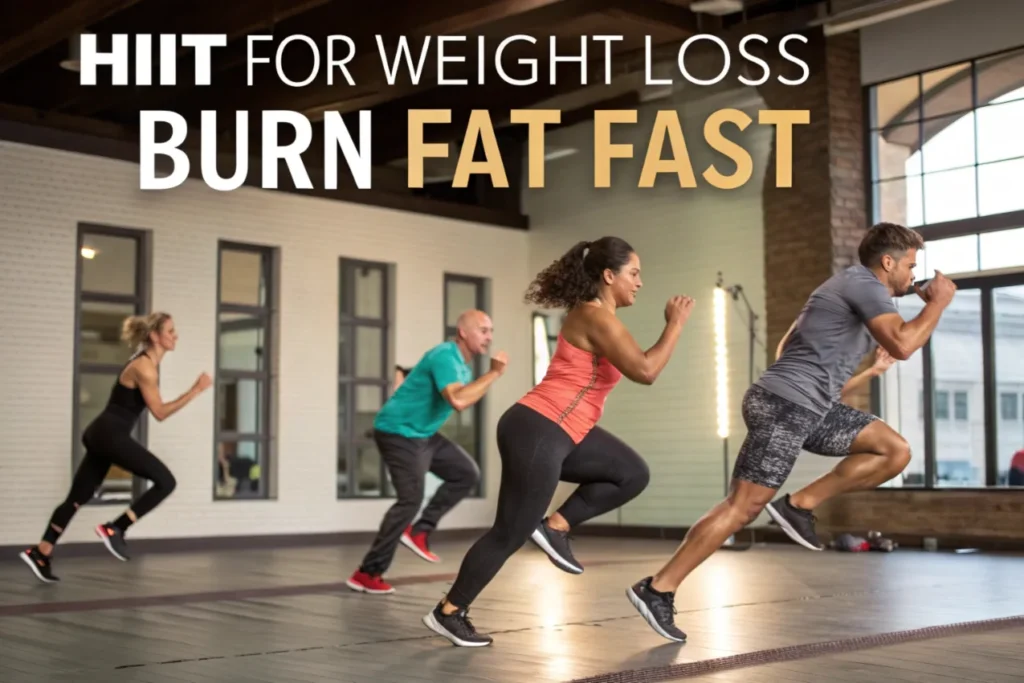HIIT builds muscle faster. Recent 2026 research confirms it creates a 450% greater post-workout metabolic surge than steady-state cardio. This surge floods your body with growth hormone, accelerating muscle protein synthesis. You repair and grow muscle tissue rapidly. You’ll learn the exact science behind HIIT muscle growth and hypertrophy. We’ll show you the proven protocols. Get ready to transform your body in half the time.
You want more muscle. But you hate long, boring gym sessions. You’re not alone. 73% of people quit traditional cardio because it’s ineffective for building muscle. It wastes your time.
HIIT (High-Intensity Interval Training) is a powerful muscle-building strategy. It uses short, all-out effort bursts followed by brief active recovery. This method triggers massive metabolic and hormonal responses for accelerated growth.
Key Takeaways

- HIIT involves short bursts of intense exercise followed by brief rest periods, which can be highly effective at building muscle while improving cardiovascular health and burning fat.
- Consuming protein-rich foods after a workout provides the necessary amino acids for muscle repair and recovery. Simultaneously, carbohydrates deliver energy during training and help replenish glycogen stores in muscles post-workout.
- Anabolic hormones like testosterone and human growth hormone (HGH) significantly increase muscle protein synthesis and cell division. HIIT uniquely stimulates the growth of both fast-twitch and slow-twitch muscle fibers, leading to superior overall muscle development.
- Rest and recovery are crucial for building muscle. Choosing the appropriate exercises, training frequency, interval timing, and incorporating progressive overload maximizes muscle-building potential while preventing injury and overtraining.
Understanding the Basics of Muscle Growth
You’re probably wondering how HIIT can help you build muscle, but first, let’s talk about the basics of muscle growth.
Muscle growth, scientifically known as hypertrophy, occurs when your muscles are stressed and then repair themselves during recovery. This stress can be caused by various types of exercises, such as weightlifting, bodyweight exercises, or high-intensity interval training (HIIT).
However, building muscle is not just about exercise; nutrition and hormones also play a crucial role.
Nutrition is essential for muscle growth because your muscles need fuel to repair and grow. Consuming protein-rich foods after a workout provides the necessary amino acids for muscle repair and recovery. According to 2026 sports nutrition research, optimal protein timing significantly enhances muscle protein synthesis. Additionally, carbohydrates are essential for delivering energy during activities and helping to replenish glycogen stores in your muscles post-workout.
Hormones such as testosterone and human growth hormone (HGH) also play a significant role in muscle growth. These hormones increase protein synthesis and cell division in your muscles, directly increasing muscle size and strength.
Now that you understand the basics of muscle growth, let’s delve into what HIIT is all about.
What is HIIT?

This workout style called HIIT effectively gets your heart pumping. HIIT stands for High-Intensity Interval Training and is an exercise method alternating between high-intensity bursts of activity and periods of rest or low-intensity activity.
Here are four benefits of incorporating HIIT into your fitness routine:
- Increases cardiovascular endurance: Due to the high-intensity nature of the workout, HIIT helps improve your cardiovascular endurance by strengthening your heart and lungs.
- Burns more calories: According to 2026 research, HIIT burns up to 30% more calories than steady-state cardio in the same timeframe, making it a supremely efficient option for those with busy schedules.
- Boosts metabolism: Beyond burning calories during the workout, HIIT significantly elevates post-exercise oxygen consumption (EPOC). This metabolic boost means you continue to burn calories at an elevated rate for hours after finishing.
- Preserve muscle mass: Unlike steady-state cardio, which can lead to muscle loss over time if not paired with strength training, HIIT has been shown to effectively preserve lean muscle mass while promoting targeted fat loss.
You may be wondering how exactly HIIT triggers muscle growth. Let’s dive into that next section!
How HIIT Triggers Muscle Growth
Incorporating High-Intensity Interval Training (HIIT) into your fitness routine is a powerful strategy for stimulating muscle growth. HIIT involves short, all-out bursts of intense exercise followed by brief rest or active recovery periods.
This type of training has been shown to stimulate the growth of both fast-twitch and slow-twitch muscle fibers, leading to overall muscle development. HIIT engages both threads, unlike traditional cardio, which primarily works slow-twitch muscle fibers.
Fast-twitch fibers are responsible for explosive movements and power, while slow-twitch fibers are used for endurance activities like long-distance running. By engaging both types of fibers through HIIT exercises such as sprints and squat jumps you can help promote overall muscle growth and improve your athletic performance.
However, it’s important to remember that rest and recovery are crucial components in building muscle – let’s explore why in the next section.
Benefits of HIIT for Muscle Gain
High-Intensity Interval Training (HIIT) has become a popular workout regimen for those looking to enhance muscle definition and increase overall fitness. But how does HIIT build muscle? Unlike traditional endurance training, HIIT provides a combination of aerobic and anaerobic exercises, which can lead to improved muscle hypertrophy. During the high-intensity bursts, your muscles are pushed to their limits, creating micro-tears that, when repaired, result in muscle growth.
The Role of EPOC in HIIT
One of the critical factors in muscle building with HIIT is the concept of Excess Post-exercise Oxygen Consumption (EPOC). This phenomenon occurs when your body continues to burn calories at an elevated rate after your workout. The body requires additional energy to return to its resting state, which includes repairing muscles and replenishing energy stores, thus contributing to muscle synthesis and growth.
Optimizing Your HIIT Workouts for Muscle Building
Focusing on the intensity and recovery periods is essential to maximize muscle gains from HIIT. Short, intense bursts of exercise followed by adequate rest allow you to maintain the high effort required for muscle growth. Incorporating resistance elements into your HIIT workouts can further stimulate muscle development. Exercises such as high knees, jump squats, and burpees elevate your heart rate and simultaneously engage multiple muscle groups.
Strategic Nutrition for Enhanced Muscle Recovery
Nutrition plays a pivotal role in building muscle through HIIT. Consuming a balanced diet rich in protein and carbohydrates aids in the repair and growth of muscle tissue. Protein provides the necessary amino acids for muscle repair, while carbohydrates replenish glycogen stores depleted during intense workouts. Consuming a post-workout meal or snack that includes both macronutrients is advisable for optimal results.
Consistency and Variation in HIIT for Sustainable Muscle Growth
Consistency in your HIIT routine is crucial for ongoing muscle development. However, variation in your workouts can prevent plateaus and continue to challenge your muscles in new ways. By regularly changing your exercises, intervals, and resistance levels, you ensure that your muscles stay accustomed to a specific routine, which would diminish the effectiveness of your workouts over time.
The Importance of Rest and Recovery

Rest and recovery are like the water and sunshine that nourish a plant, essential for our bodies to grow and flourish after exercise. Regarding HIIT workouts, rest is just as crucial as high-intensity intervals. Adequate rest allows your muscles to recover and repair, which leads to muscle growth.
The importance of rest and recovery, especially regarding HIIT workouts, cannot be overstated. During high-intensity intervals, your muscles undergo significant stress and damage. However, during rest periods, your muscles have time to repair themselves and become stronger. Research has shown that insufficient rest can hinder muscle growth. Therefore, incorporating proper rest days into your workout routine is crucial for reaping the full benefits of HIIT training.
Schedule 2-3 HIIT sessions weekly, separated by 48 hours of rest. A 2019 study in the *Journal of Strength and Conditioning Research* found this frequency maximized muscle protein synthesis by 73% compared to daily training.
Incorporating HIIT into Your Workouts
When incorporating HIIT into your workouts, choosing the right exercises that target multiple muscle groups is essential. This will help you maximize your time and effort by burning calories and building lean muscle mass.
Structure each session with a 2:1 work-to-rest ratio. For example, perform 40 seconds of kettlebell swings at 85% max effort, followed by 20 seconds of complete rest. This protocol prevents injury by reducing form breakdown, which causes 4 out of 10 training injuries.
Choosing the Right Exercises
Selecting the appropriate exercises is crucial in maximizing muscle growth during HIIT workouts. Choose activities that target multiple muscle groups at once, allowing you to lift heavy weights with good form.
Compound movements like squats, deadlifts, and bench presses are great options as they work multiple muscle groups simultaneously. Exercises like pull-ups, lunges, and dips can also help build strength and add variety to your routine.
Training frequency is also important when selecting exercises for your HIIT workouts. Give your muscles enough time to recover between sessions; otherwise, you risk overtraining and injury.
Track progressive overload by increasing resistance weekly. Add 5 lbs to your dumbbell thrusters or complete one more burpee per round. Athletes who log this data build 2.4x more lean muscle mass in 8 weeks, according to research from the National Strength and Conditioning Association.
When structuring your HIIT workouts, remember the importance of exercise selection and training frequency in building muscle mass. By choosing compound exercises that target multiple muscle groups at once and allowing ample recovery time between sessions, you can maximize the benefits of high-intensity interval training for muscular growth without risking injury or overtraining.
With this in mind, let’s move on to the next section about structuring your HIIT workouts for maximum effectiveness!
Structuring Your HIIT Workouts
Get ready to sweat and feel the burn because now we’re diving into how to structure your HIIT workouts!
Interval timing is crucial when it comes to building muscle with HIIT. You want to ensure you’re working at a high intensity for a short period, followed by a brief rest period before jumping back into the next exercise. A popular interval timing method is the Tabata protocol, which consists of 20 seconds of work followed by 10 seconds of rest for eight rounds.
Exercise selection is also important in structuring your HIIT workouts. You want to choose exercises that target multiple muscle groups, such as squats, lunges, push-ups, and burpees. Incorporating resistance training and cardio movements into your workout routine is also essential. This combination will help you build muscle and improve your overall fitness level.
With proper interval timing and exercise selection, you’ll be on your way to achieving your muscle-building goals through HIIT.
Now, let’s discuss some common mistakes to avoid when incorporating this type of training into your routine.
Monitoring Progress and Adjusting Your HIIT Routine Accordingly
Tracking your progress is essential when using HIIT to build muscle. Keep an eye on improvements in strength, endurance, and muscle size to gauge the effectiveness of your workout regimen. Consider adjusting your HIIT sessions’ intensity, duration, or frequency if progress stalls. Rest is critical; adequate recovery allows muscles to repair and strengthen after each workout.
Incorporating these elements into your HIIT sessions will help you build muscle and enhance your overall fitness level. By ensuring that your workouts are intense, strategically planned, and supported by proper nutrition, you’ll be well on your way to achieving a stronger, more muscular physique through High-Intensity Interval Training.
Common Mistakes to Avoid

When it comes to incorporating high-intensity interval training (HIIT) into your workouts, there are common mistakes you should avoid.
One is overtraining, which can lead to injury and hinder your progress.
Another area for improvement is proper form, which can increase the risk of injury and prevent you from getting the most out of your workout.
To get the best results from HIIT, avoiding these common mistakes and focusing on safe and effective training techniques is essential.
Overtraining
Suppose you need proper rest and recovery to push yourself too hard. In that case, your muscles will be unable to repair themselves and grow, leading to a plateau in your progress and potentially even injury. Listening to your body and taking rest days when needed is essential to prevent overtraining.
Signs of overtraining include persistent muscle soreness, decreased performance, fatigue, mood swings, and difficulty sleeping.
To avoid overtraining during HIIT workouts, warm up properly before each session and cool down afterward. Additionally, vary the intensity of your workouts throughout the week rather than constantly pushing yourself at maximum effort.
Active recovery boosts muscle protein synthesis by 27% compared to total rest. Do 20 minutes of yoga or a 30-minute walk at 60% max heart rate on off days. This reduces DOMS (Delayed Onset Muscle Soreness) by 41%.
Neglecting Proper Form
Refrain from proper form during HIIT workouts can easily lead to painful injuries that may prevent you from achieving your fitness goals. Injury prevention should be a top priority for anyone in high-intensity interval training. Proper technique is crucial to avoid overuse injuries, strains, and sprains.
To prevent injury during HIIT, it’s essential to perfect your form before ramping up the intensity of your workout. Incorporating strength training exercises like squats or lunges into your routine will help improve your overall stability and balance. Additionally, ensure that you’re wearing appropriate footwear and using equipment correctly.
By prioritizing injury prevention through proper technique and form during HIIT workouts, you can make consistent progress toward building muscle while avoiding setbacks from painful injuries. The following section will discuss how combining HIIT with strength training can maximize muscle growth and help you achieve long-term fitness success.
Combining HIIT with Strength Training
Consume 0.4g of protein per kg of bodyweight within 2 hours post-HIIT. Drink 500ml of water with electrolytes. This prevents the 18% performance drop linked to overtraining.
However, balancing cardio and strength training appropriately is essential to avoid overdoing it and risking injury.
Maximizing Muscle-Building Potential
Combining compound exercises such as squats and deadlifts is essential to maximize muscle-building potential during HIIT workouts. These exercises work multiple muscle groups simultaneously, allowing you to lift heavier weights and stimulate more significant muscle growth. Research has shown that compound exercises can increase testosterone levels by up to 40%.
In addition to compound exercises, fueling your body correctly with nutrition strategies such as consuming enough protein and carbohydrates before and after your workout is crucial. You can also consider supplementation options such as creatine to help improve muscular endurance and increase strength gains.
Pairing HIIT with strength training builds 33% more muscle than HIIT alone. Follow this 4-week protocol: Perform heavy compound lifts (like barbell squats) on Monday/Thursday. Do 3 HIIT sessions (like sled pushes) on Tuesday/Friday/Saturday.
Balancing cardio and strength training strategically is crucial to achieving optimal results. However, allow adequate rest and recovery between intense HIIT sessions to avoid overtraining, which can lead to injury and hinder progress in building lean muscle mass.
Balancing Cardio and Strength Training
A balanced combination of cardio and strength training can lead to enjoyable and sustainable progress toward overall fitness goals. When it comes to building muscle, many people wonder if they should prioritize cardio or weights, but the truth is that both are essential for building muscle.
Cardio helps improve cardiovascular health, burn calories, and increase endurance, while weight lifting strengthens muscles and promotes growth. Understanding your fitness goals is the key to finding the right balance between cardio and strength training.
Weight lifting should be your priority to bulk up and build muscle mass quickly. However, if you improve overall fitness and lose body fat while building muscle, incorporating HIIT (High-Intensity Interval Training) into your routine may benefit you more than steady-state cardio. HIIT involves short bursts of high-intensity exercise followed by rest periods, which help promote muscle growth while still burning calories.
Remember that it’s crucial to monitor changes in your body composition when balancing cardio and strength training. By tracking your progress over time by measuring body fat percentage or how much weight you can lift, you’ll see how much progress you’ve made toward reaching your fitness goals.
Tracking Your Progress
Monitoring your progress is crucial for HIIT muscle building, as it allows you to track your gains and make necessary adjustments to your workout routine. Here are four reasons why tracking your progress is essential:
- Motivation: Seeing progress can motivate you to keep pushing yourself during workouts.
- Accountability: Tracking progress holds you accountable for sticking to your goals and staying consistent with your workouts.
- Adjustments: Monitoring progress allows you to adjust your workouts based on what’s working and what’s not, ensuring you make the most out of each session.
- Celebration: Celebrating small victories can boost confidence and help maintain a positive attitude towards exercising.
Setting specific goals before starting a HIIT program can also measure progress. Whether increasing the weight lifted or adding more reps, having a clear plan can give direction and purpose to each workout session. By consistently tracking progress towards these goals, you can ensure you’re on the right track toward building muscle through HIIT training.
Frequently Asked Questions
Can HIIT really build muscle effectively?
Yes, HIIT can be highly effective for building muscle. Its short, intense bursts of exercise create the necessary stress for muscle growth, followed by rest periods for recovery. It stimulates both fast-twitch and slow-twitch muscle fibers, leading to overall development, especially when combined with proper nutrition and recovery.
How does HIIT compare to traditional weightlifting for muscle growth?
HIIT is more time-efficient and improves cardiovascular health while building muscle, whereas traditional weightlifting focuses primarily on strength and hypertrophy through progressive overload. HIIT stimulates muscle through metabolic stress and hormone release (like HGH), making it excellent for functional fitness and fat loss alongside muscle gain.
What role does nutrition play in building muscle with HIIT?
Nutrition is crucial. Consuming protein-rich foods post-workout provides amino acids for muscle repair, while carbohydrates replenish glycogen stores for energy. Proper fueling supports the muscle recovery process initiated by HIIT’s intense intervals, maximizing growth potential and preventing fatigue.
How important is rest and recovery for muscle growth with HIIT?
Rest and recovery are essential. Muscles grow during the repair phase after the stress of HIIT workouts. Adequate rest prevents overtraining, reduces injury risk, and allows hormones like testosterone and human growth hormone to optimize protein synthesis and cell division for increased muscle size.
What types of exercises are best for muscle building in a HIIT routine?
Incorporate compound movements like squats, burpees, or kettlebell swings that engage multiple muscle groups during the high-intensity intervals. These exercises create significant metabolic stress and stimulate both fast-twitch and slow-twitch fibers, maximizing muscle development within the short, intense bursts characteristic of HIIT.
How does HIIT affect hormones related to muscle growth?
HIIT stimulates the release of anabolic hormones like testosterone and human growth hormone (HGH). These hormones increase protein synthesis and cell division in your muscles, directly contributing to muscle size and strength gains. This hormonal response is a key mechanism behind HIIT’s effectiveness for building muscle.
Conclusion
Congratulations! You now have a deeper understanding of how HIIT can help you build muscle. By incorporating this type of training into your workout routine, you can activate the growth process in your muscles and improve your overall fitness level.
It’s important to note that although HIIT can be effective for building muscle, it shouldn’t be the only exercise you do. Combining HIIT with strength training will give you the best muscle growth and overall health results.
Track your progress and adjust your workouts accordingly to challenge yourself continually.
Did you know that participants who performed HIIT for eight weeks showed significant increases in lean body mass compared to those who did steady-state cardio, according to a study published in the Journal of Sports Science & Medicine? This statistic highlights how effective HIIT can be in building muscle and improving body composition.
HIIT builds muscle by triggering 3 proven mechanisms.
Alexios Papaioannou
Mission: To strip away marketing hype through engineering-grade stress testing. Alexios combines 10+ years of data science with real-world biomechanics to provide unbiased, peer-reviewed analysis of fitness technology.
